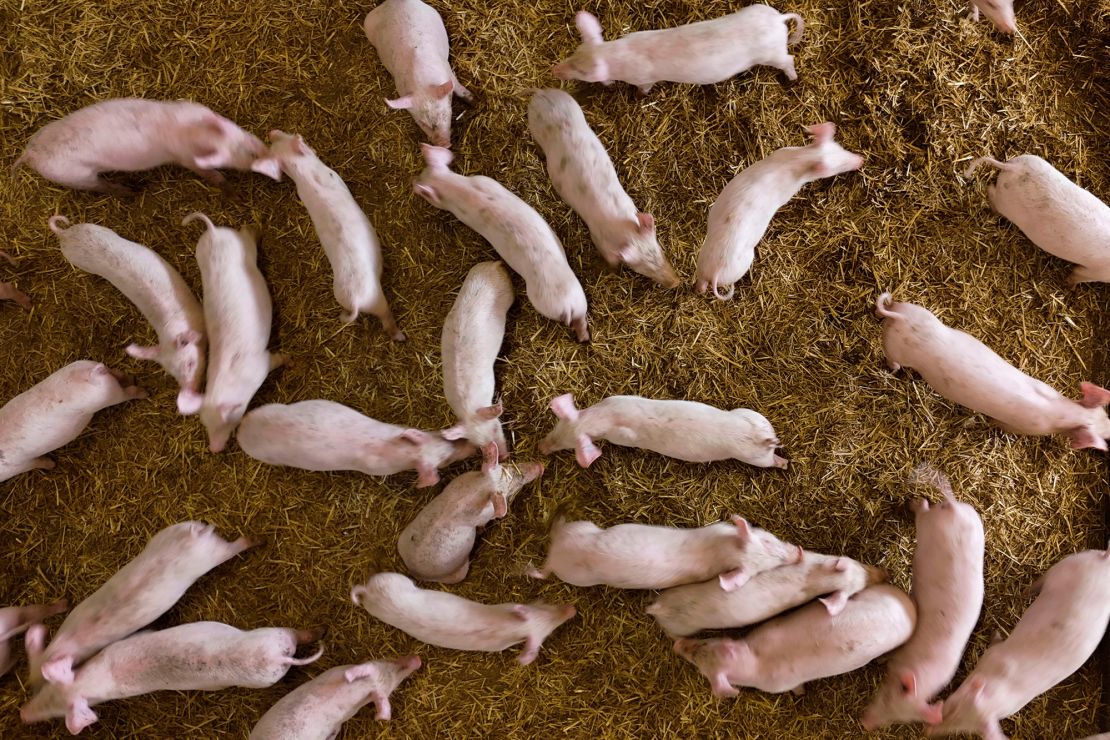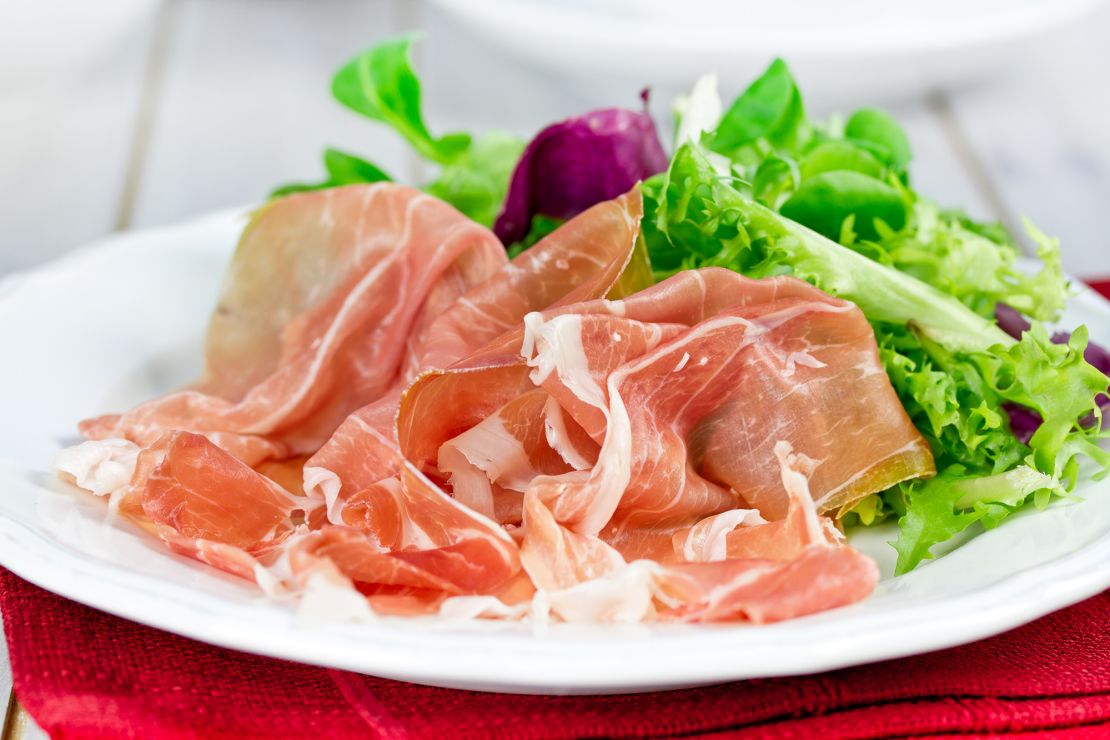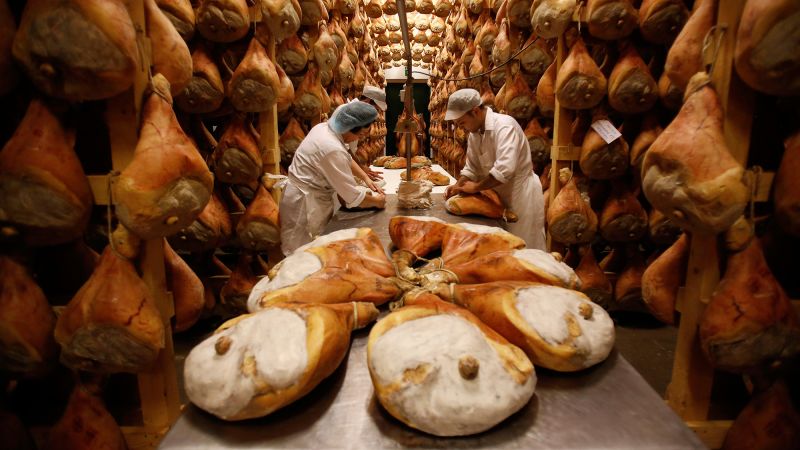For travel tips, recipes and more insight on Italian culture, sign up for CNN’s Unlocking Italy newsletter. This eight-part guide will have you packing your bags in no time.
There’s nothing quite like the mouthwatering taste of real Prosciutto di Parma, known the world over as Parma ham.
The Italian delicacy, which generates an annual turnover of $1.6 billion, is prized by Italians and enjoys a protected status — only meat cured in the northern region of Emilia Romagna using just Italian-grown pork legs, salt and air can be certified as authentic by the Parma Ham Consortium.
Tourists regularly flock to the region, known for other epicurean delights like balsamic vinegar and Parmesan cheese, to savor the tastiest cuts in their place of origin, bringing in more income as they join guided tours of ham producers.
But all is not well in ham country. A warming climate and the spread of viruses affecting the pigs are causing big problems for Italian pork. The end result is that Parma ham as we know it is increasingly hard to find on international dinner plates.
Unlike many heavily mechanized meat processing industries, Parma ham production is steeped in history and tradition.
In factories like the Slega prosciuttificio, in the hamlet of Langhirano near the city of Parma, Stefano Borchini remembers his father teaching him methods of curing Parma ham that date back to Roman times, when local salt was used to preserve the meat.
The Italian-grown pig’s hind leg is carefully butchered and then salted by a maestro salatore, or salt master, and then left for about a week in a cooling room to begin a process that must take at least 400 days and can be cured for up to three years to create the finest aged Parma ham.
‘Meat, salt, time and air’
Parma ham is salted twice, grease-sealed with a lard and salt mixture, and then left to cure in climate-controlled rooms. When possible, curing room windows are left open to let in the clean local air.
“My father founded this company, and my first job in the factory was to swat the flies when I was six years old,” Borchini says. “You have a passion for this product, like a wine producer, it’s the same. When you produce food, it’s special. You put your heart in what you do.”
Each of the 40,000 to 50,000 legs of ham the company produces each year is cured the same exact way, and tested for quality with a needle made from horse bone. The needle is stuck into the curing ham in several places and pulled out to check the smell to ensure food safety.
Borchini explains the final phases of the curing process are fine tuned by opening and closing windows to let in the fresh air on cool nights, just the way his father taught him to do. “Meat, salt, time and air is what it takes,” he says.
The process — and the product — draws hundreds of thousands of foodies and curious visitors from all over the world to the area each year to take food tours. Up and down the streets of Parma and little hamlets like Langhirano, small tour groups taste the delicacies, often in conjunction with the area’s other delicacies including Parmiggiano Reggiano (or Parmesan cheese), balsamic vinegar from Modena and local wine.
But lately, threats like manmade climate change and diseases like African swine fever have challenged the ham industry.
Borchini says that a few years ago his business had to install air conditioning systems in the curing rooms because the air doesn’t cool down like it used to.
“We no longer have the fresh cool nights during the summer that we had before, but we are lucky that we can continue,” he says. “It has changed by one or two degrees warmer at night than 15 years ago, which means we have had to adjust.”

African swine fever, a highly contagious disease that can be fatal to pigs, has also had an impact on production. Although not a danger to humans, the virus can be spread by people, including through the consumption of infected meat. That’s led to strict controls in Italy and beyond.
Borchini says there’s been a reduction in pork legs of around 8%, and a drastic hike in costs, as a consequence.
“We are finding that there are just not as many fresh pork legs to meet our needs because of restrictions and controls,” he says. “We have difficulties in raw materials and the price has increased because there is less pork than usual. The supply is less than the demand, and the price has risen.”
Around 80 miles north of Parma, near Brescia in the northern region of Lombardy, the air is very different.
On Alberto Cavagnini’s farm, the atmosphere is heavy with the strong scent of pigs. But they are nowhere to be seen, essentially kept under lockdown to protect them from the swine fever virus. Cavagnini produces pork for products including Parma ham and San Daniele ham — a similar cured meat originating in Italy’s northeastern Friuli region. These are exported all over the world.
Cavagnini has had to cull more than 2,000 of his animals after the virus, thought to have been introduced by wild boar, was detected in one of his pig barns earlier this year. The government, which has appointed a special commissioner to help manage the crisis, requires the destruction of all animals on farms where the virus has been detected.
“It’s obligatory to destroy the animals because the virus is so contagious,” he says. Workers take strict safety measures, including showering before they are in contact with his pigs, to avoid accidental spread of the virus, which is not airborne but easily carried on shoes or clothing.
“There is no option but to put down the infected animals because 95% of the animals will die in a painful way,” he says.

In all, more than 200,000 pigs have been killed in the region of Lombardy since the virus was detected in 2021 and nearly 90,000 in the last two months.
The situation is slowly coming under control, but for some pork producers it’s too late.
Almost a dozen pig farms have had to close in Italy since the virus outbreak. It has also been devastating for producers who rely on international markets, since European Union regulations ban pork exports from regions in the swine fever “red zone.”
Davide Calderone, head of the Assisca association of Italy’s meat and cured meat producers, says the Italian pork industry, which extends to sausages, mortadella and salami, has an annual turnover of around $9 billion. Were it not for the virus, exports should be accounting for $2 billion.
In the last year, several countries have all banned Italian pork exports.
“China, Japan, Taiwan have completely closed the market because of African swine fever,” Calderone says. “Other countries, for example Canada, the United States, Brazil recognize the European system with regionalization bans depending on where the virus has been detected.”
Calderone says Italy has been able to maintain pork exports to many countries with some limitations. “We are trying to convince them about the system, about the safety, and the animal health of our products,” he says.
Back in Parma, there is no convincing necessary. A steady flow of food tourists stream in and out of the delis and showrooms to savor the ancient delicacy, perhaps unaware of the challenges behind producing each scrumptious leg of ham but clearly grateful for the experience.
Read the full article here


